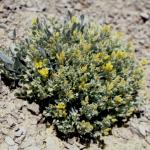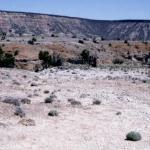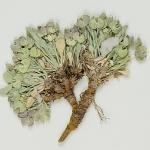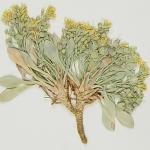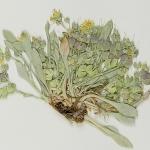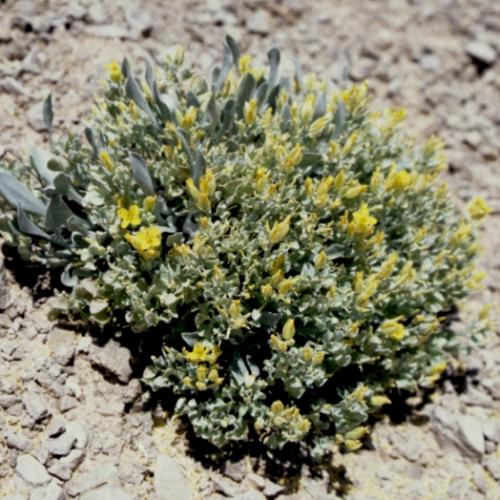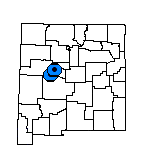Physaria newberryi var. yesicola (Yeso Twinpod)
NONE
| USFWS | State of NM | USFS | BLM | Navajo Nation | State Rank | Global Rank | R-E-D Code | NMRPTC Status | Strategy Status |
|---|---|---|---|---|---|---|---|---|---|
| SEN | S1 | 2-1-3 | R | SS |
| Overall Conservation Status | Documented Threats | Actions Needed |
|---|---|---|
| UNDER CONSERVED | No Information |
Status surveys on abundance, distribution and threats |
Long-lived, low growing perennial with diffusely branching root crown (caudex) forming mounded clumps 1-3 dm in diameter; herbage densely covered with overlapping gear-shaped (stellate-discoid) trichomes; stems 3-10 cm long; basal leaves narrowly oblanceolate to broadly spatulate, acute or blunt at tips, 3-8 cm long; stem leaves narrow and smaller than basal leaves; inflorescence a few-flowered raceme, 2.5-5 cm long; pedicels 6-11 mm long; flowers about 10 mm wide, petals 4, yellow; fruits (silicles) papery with sharp-angled edges, about 10 mm wide and almost as long, X-shaped in cross-section and with a deep V-shaped notch at the apex; fruiting styles slender, 5-9 mm long. Flowers April and May.
Physaria newberryi is distinguished from other Physaria species by the sharply angled margins of its fruits. Variety newberryi has short, stubby fruiting styles about 2-3 mm long and is less deeply notched at fruit apex.
New Mexico, southeastern Cibola and western Valencia counties, Sierra Lucero Range (including Mesa Lucero).
Sandy gypsum and silty strata of the Yeso Formation in short grass steppe and juniper savanna; 1,750-2,100 m (5,700-6,900 ft).
A unique gysophilic variety with long styles, forming large mounds in nearly barren badlands. The larger plants appear to be very old. Variety yesicola is disjunct from var. newberryi of northwestern New Mexico and is the southeastern range extreme for the species.
The habitats of this narrow endemic are remote badlands where the only current land uses are infrequent livestock grazing and occasional gas exploration. Significant impacts caused by feral horses in the Sierra Lucero area in Cibola County have been documented.
Rollins, R.C. 1993. The Cruciferae of continental North America. Stanford University Press, Stanford, California.
*Sivinski, R.C. 1999. A new variety of Physaria newberryi (Brassicaceae) from New Mexico. Sida 19:673-677.
For distribution maps and more information, visit Natural Heritage New Mexico

